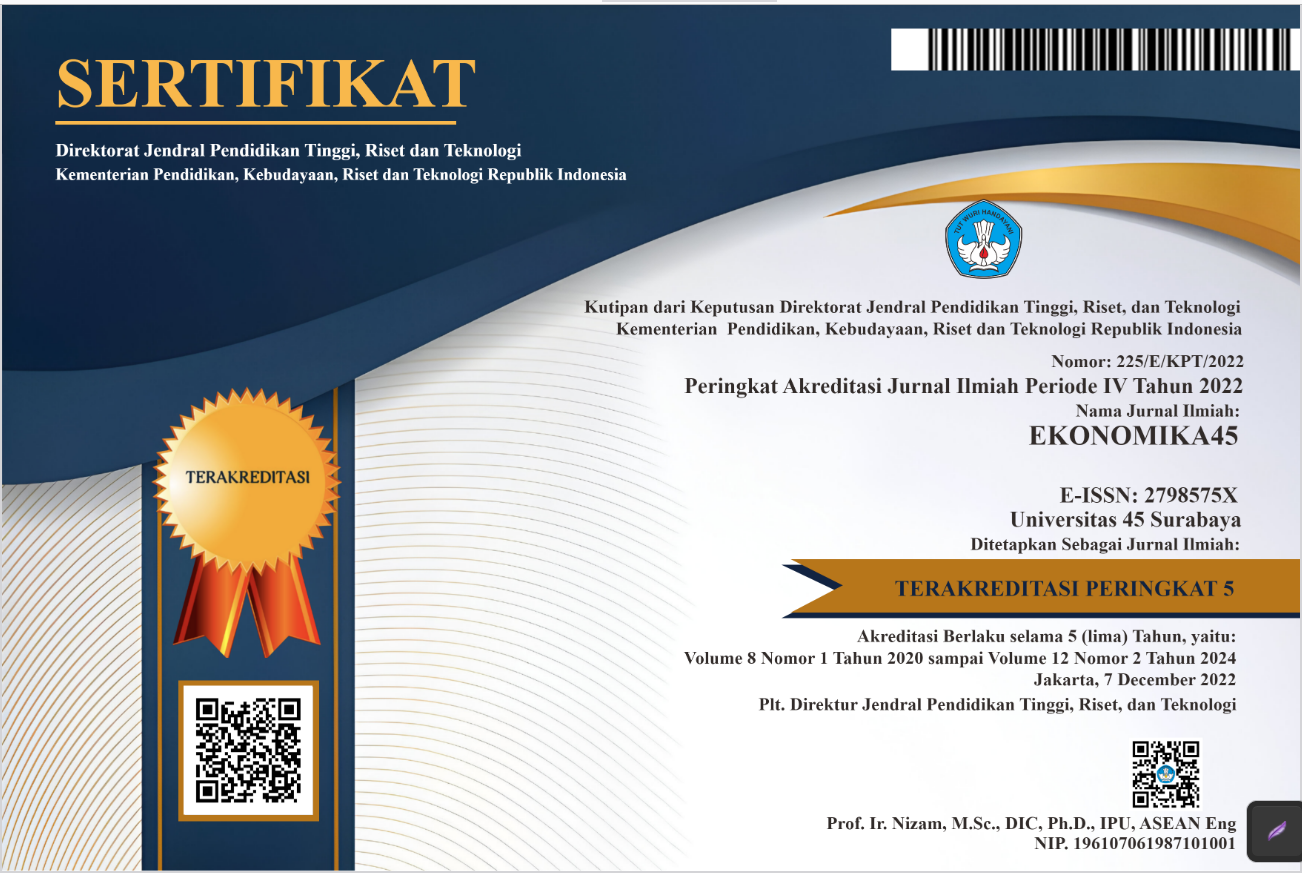Analisis Manajemen Kolaboratif Model Pentahelix Sebagai Strategi Pengelolaan Objek Wisata Pemandian Air Panas Desa Sumberarum Kabupaten Magelang
DOI:
https://doi.org/10.30640/ekonomika45.v11i2.2542Keywords:
strategy management, model pentahelix, attractions, SWOTAbstract
This research is motivated by the lack of availability of facilities and infrastructure, competition between managers and lack of human resources in the management of tourism objects. The location of this bathhouse is located in Dimajar Hamlet, Sumberarum Village, Tempuran District, Magelang Regency. The formulation of this research problem is how to analyze the application of the Pentahelix Model Collaborative Management as a Tourism Object Management Strategy in the Hot Springs of Sumberarum Village, Magelang Regency. This research uses the theory of strategic management from Fred R David (2004). By using SWOT analysis technique (Strengths, Weakness, Opportunities, Treaths) and with qualitative descriptive method. The results showed that Sumberarum Village has the strength to advance the tourism sector through the utilization of its natural resources, hot springs as the main attraction as a Hot Springs Tourism Object in Sumberarum Village. Meanwhile, the weakness is the human resources involved from among the local residents or residents of Sumberarum Village, still have limitations both in terms of quality and quantity. In addition, the management system of this tourist attraction is also not well structured so that it can affect the success of achieving organizational goals. The existence of the Sumberarum Village Hot Springs Tourism Object opens up extensive opportunities for local residents to create new jobs. The number of hot springs in Sumberarum Village is a threat in the competition for the management of hot spring tourism objects in the area due to the location of tourist objects that are close to each other. The suggestions of this research are (1) increasing the human resources involved (2) improving the structured tourist attraction management system (3) opening up jobs for residents around tourist objects (4) increasing unique innovations and maintaining cooperation between stakeholders.
References
Aribowo, H., Wirapraja, A., & Putra, Y. D. (2018). Implementasi Kolaborasi Model Pentahelix Dalam Rangka Mengembangkan Potensi Pariwisata Di Jawa Timur Serta Meningkatkan Perekonomian Domestik. Jurnal Mebis (Manajemen Dan Bisnis), 3(1), 31–38. https://doi.org/10.33005/mebis.v3i1.21
Aziz Sholeh, Abdul et. Al. 2024. Kompensasi Terhadap Motivasi Kerja Karyawan pada PT. Insolent Raya di Surabaya, Journal Of Management and Creative Business Vol. 2 No. 1 Januari 2024, Halaman : 82 - 96
Pandu Widodo, Hesti et. al. 2024. Dampak Pelatihan, Motivasi dan Lingkungan Kerja pada Kinerja Karyawan PT. KAI (Persero) di Stasiun Surabaya Pasar Turi, Journal Of Management and Creative Business 2 (1) , 66 - 8
Dahlan, & Darwis, M. (2017). Prinsip Manajemen Kolaborasi Pembinaan Anak Jalanan di Kota Makassar. Jurnal Administrare, 42-57.
Damanik, J., 2013. Pariwisata Indonesia: antara peluang dan tantangan. Pustaka Pelajar.
Enny Istanti1), Bramastyo Kusumo2), I. N. (2020). IMPLEMENTASI HARGA, KUALITAS PELAYANAN DAN PEMBELIAN BERULANG PADA PENJUALAN PRODUK GAMIS AFIFATHIN. Ekonomika 45, 8(1), 1–10
Febriana, Y. E., & Pangestuti, E. (2018). Analisis Dampak Pengembangan Kepariwisataan Dalam Menunjang Keberlanjutan Ekonomi dan Sosial Budaya Lokal Masyarakat (Studi pada Desa Wisata Gubugklakah, Kecamatan Poncokusumo, Kabupaten Malang) Yusrisa. Jurnal Administrasi Bisnis (JAB), 61(4), 143–150.
Firdani, P. (2014). Deskripsi Dasar Kabupaten Magelang. In Academia. https://www.academia.edu/8875346/Deskripsi_Dasar_Kabupaten_Magelang Indonesia, K. P. (2016). Salinan Peraturan Menteri Pariwisata Republik Indonesia Nomor 1 Tahun 2016 Tentang Penyelenggaraan Sertifikasi Usaha Pariwisata. Diambil kembali dari http://www.kemenpar.go.id/
Istiyanti, D. (2020). Pemberdayaan Masyarakat Melalui Pengembangan Desa Wisata di Desa Sukawening ( Community Empowerment Through Development of Tourist Villages in Sukawening Village ). Jurnal Pusat Inovasi Masyarakat, 2(1), 53–62.
JDIH Kabupaten Magelang. (2023). JDIH KABUPATEN MAGELANG. Magelangkab.go.id. https://jdih.magelangkab.go.id/hukum/detail/peraturanbupati/70/2021 Kabupaten Magelang. (2019). Magelangkab.go.id. https://pariwisata.magelangkab.go.id/
Kirana, C. A. D., & Artisa, R. A. (2020). Pengembangan Desa Wisata Berbasis Collaborative Governance di Kota Batu. Kolaborasi : Jurnal Administrasi Publik, 6(1), 68–84. https://doi.org/10.26618/kjap.v6i1.3119
Nurjanah, S. D. (2016). Manajemen Strategi Pengelolaan Objek Wisata Air Panas Cisolong Kabupaten Pandeglang. 1–268.
Prabowo, S., Hamid, D., & Prasetya, A. (2016). Analisis Partisipasi Masyarakat Dalam Pengembangan Desa Wisata (Studi Pada Desa Pujonkidul Kecamatan Pujon Kabupaten Malang). Jurnal Administrasi Bisnis S1 Universitas Brawijaya, 33(2), 18–24.
Situngkir, B., Lubis, Z., & Kadir, A. (2020). Peluang Pelaksanaan Manajemen Kolaboratif dalam Pengembangan Kawasan Situs Kota Cina sebagai Potensi Pariwisata di Kota Medan. PERSPEKTIF, 149-167.
Downloads
Published
How to Cite
Issue
Section
License
Copyright (c) 2024 EKONOMIKA45 : Jurnal Ilmiah Manajemen, Ekonomi Bisnis, Kewirausahaan

This work is licensed under a Creative Commons Attribution-ShareAlike 4.0 International License.









